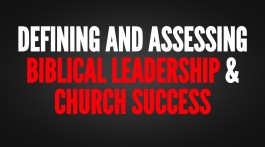Part of my desire to blog is to post the papers I write in seminary. I am currently in four leadership classes and I have been doing tons of research on great subjects concerning the church and its ability to fulfill the Great Commission.
Here is a paper on “Strategic Planning for the Church,”
Definition of Strategic Planning
Strategic planning “determines where an organization is going over the next year or more, how it’s going to get there and how it’ll know if it got there or not.” Therefore, strategic planning is used for all types of organizations such as businesses, governments, schools, and non-for-profit organizations.
Description of Strategic Planning
Good strategic planning will contain the following components:
(1) Strategic Analysis: This includes conducting some sort of scan, or review, of the organization’s environment- for example, of the political, social, economic and technical environment.
(2) Setting Strategic Direction: This section contains; vision statements, mission statements, core values, and goals.
(3) Action Planning: Such things as; organizational charts, tactics, budgets, timelines, and evaluation systems.
Benefits for Strategic Planning in the Church
Here is list of reasons why using strategic planning in the church can be useful in fulfilling the Great Commission:
(1) Clear Purpose: The church will gain a clear vision, mission statement, and core values to impart to all its members.
(2) Unified Efforts: The church can give “easy to follow” steps to its workers in the form of flow charts, strategies, and timelines.
(3) Accountability: The church leadership will have a better grasp of all the leaders, ministries, and functions of the church through evaluations and specific monitoring of each area of ministry.
Strategic Planning is Biblical
Strategic planning was utilized in many different forms throughout both the Old and New Testament. For example:
(1) Jethro: God sent Moses Jethro, his father-n-law, to give specific plans to organize the leadership of the tribes of Israel which made a functioning flow of authority and task management- Genesis 18:17-23.
(2) Nehemiah: Nehemiah was a God-appointed leader who used a strategy. When God laid it on his heart to rebuild the walls of Jerusalem, Nehemiah began to establish and then work through a well-planned strategy to accomplish the vision God had given. He assessed the damage. He secured the resources. He established leaders and distributed the assignments among them- see the book of Nehemiah.
(3) Jesus: He used the twelve to build His church, groups of 100’s to feed the fish, and the strategy of multiplication to spread the Gospel around the world- Matthew 28:18-20.
My Personal Thoughts on Strategic Planning in the Church
I am fully convinced that strategic planning is both Biblical and essential for all churches and Christian ministries to succeed. Here are some reasons to support my belief from the Bible and personal experience:
(1) Paul’s Ministry: Paul’s mission trips were planned with a strategy- Romans 15:23-25, his design of the church’s infrastructure in the offices of Elders and Deacons- 1 Timothy 3, and Paul’s letters to the churches were a form of evaluation and further training- Galatians and Titus.
(2) My Personal Experience: I started my first church at the age of 22 years old, 6 months out of Bible college, and with only 3 years of Christian experience. Therefore, the effort had massive amounts of passion and good ideas, but very little in the areas of discipleship programs, flow charts, budgets, and timelines. As a result, the work needed to be merged with another church after only 4.5 years to survive and I was forced to take a youth pastor job in another city.
However, the second church I started was when I was 28 years old, over 8 years after Bible College, and with 10 years of Christian experience. Therefore, I started the church will clear vision statements, goals, and strategies. As a result, the church has grown at a rate of 30% or more a year. We have just passed the five year mark and are making timelines for growth that predict 40% growth for each year in the next five years!
How to Make a Strategic Plan for a Church Plant
Here are some ten helpful steps to make a strategic plan for a new church:
(1) Prayer: Prayerfully consider the “Type A” person the church desires to reach.
(2) Strategic Analysis: Do strategic analyses to find the best location to reach the people desired, such studies as demographic studies and “on the street” interviews.
(3) Location: Determine the location of the new congregation based on the “type A” person the church desires to reach.
(4) Leadership Structures: Write out a clear flow chart, job descriptions, and recruitment plan.
(5) Leadership Gathering: Begin gathering the right leadership through meetings and interviews. After the desired leadership is found begin holding weekly meetings and start designing the church’s strategic direction.
(6) Strategic Direction: With the leadership team design the following: (a) Name, (b) Vision Statement, (c) Objectives, (d) Core Values, (e) Strategies, (f) Timeline for Growth, (h) Measurable Goals, and (i) Budget.
(7) Promotion: Begin to promote and evangelize the area desired to reach and to start the church.
(8) Small Groups: Have a planning small group once a week with the leadership and a open small group to invite the visitors being reached.
(9) Launch Service: Plan a launch service when the church begins meeting once a week and the ministries planned start to function.
(10) Quarterly Review: Every three months review the churches (a) Leadership, (b) Strategic Direction, and (c) Goals in relation to the timeline.
Great Web and Book Sources:
(1) How to Start a Small Business: Great for churches as well, put out by the government, cool slide show
(2) Definitions of Strategic Planning: Great insight and easy to read articles
(3) Simple Church, by Rainer & Geiger: Well written book on simple yet powerful strategies for planting growing churches
(4) Metro Revolution: Here is the vision and plan for our movement



